This Coal Plant Endangers Forests, Wildlife, People. And India Doesn't Even Need It, Experts Say
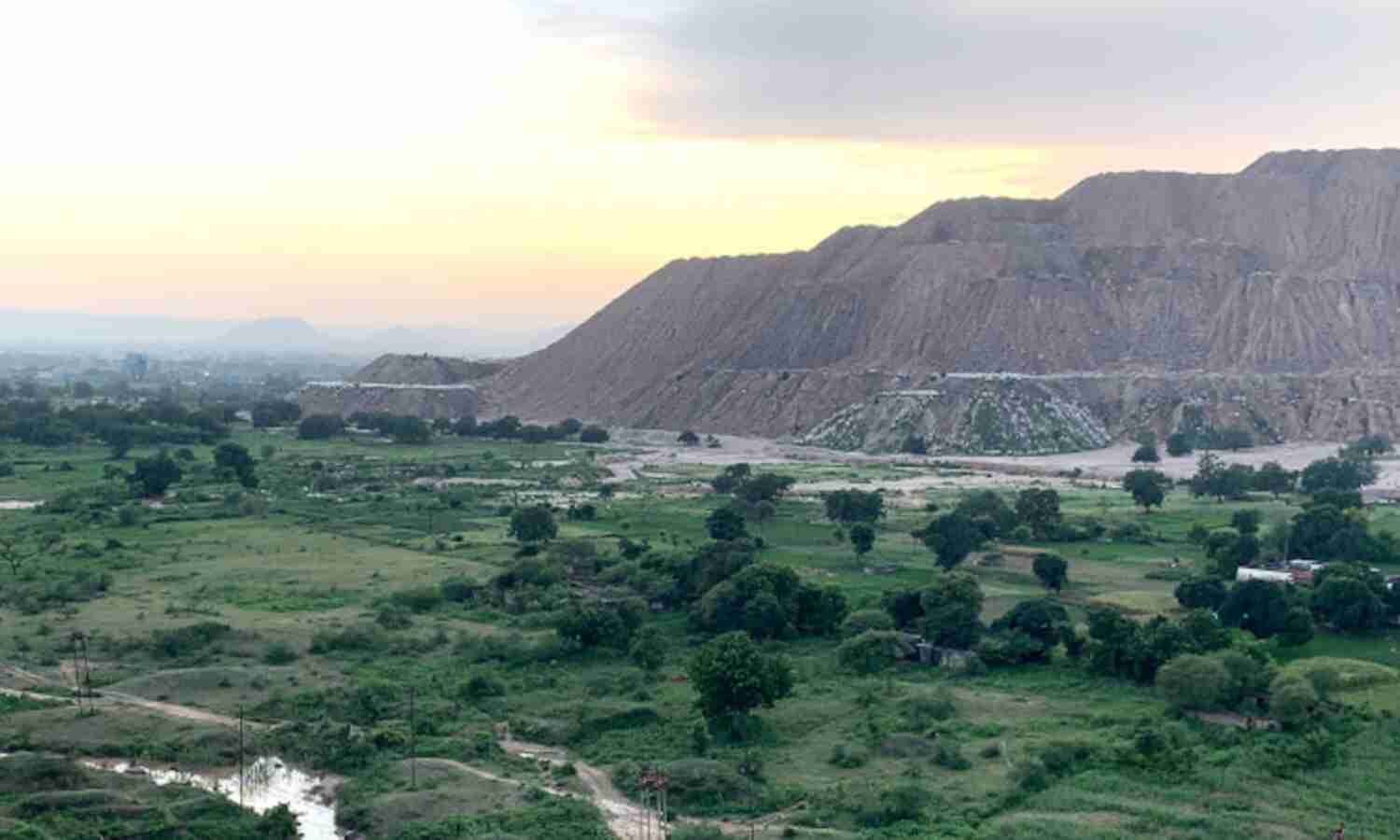

Editor's note: This series was produced in partnership with the Pulitzer Center. The story contains footnotes marked with asterisks
Singrauli, Madhya Pradesh: For years, Mandhari Singh slept easy, happy that his land had escaped the clutches of a local mining company.
So when a sign appeared overnight in his village in 2017 stating that his land had again been allocated to a mining project, a fresh nightmare began to unravel for the 50-year-old farmer and the other inhabitants of Pidarwah, a remote village about 600 km from Bhopal, in the heart of central India's coal belt.
"Nothing happened for years," Singh told IndiaSpend. "We thought we were safe... especially since this area is already so full of mines. This new notice has filled us with dread."
Singh's maize fields are among the 1,900 hectares that the Ministry of Coal allotted to THDC India Limited (THDCIL; formerly known as Tehri Hydro Development Corporation) in January 2017 for coal mining. Earlier, in 2007 too, his land had been allocated for a coal mine project by the Madhya Pradesh State Mining Corporation (MPSMC). That project came to naught.
THDCIL is a publicly-owned joint venture between the Uttar Pradesh government and the National Thermal Power Corporation, which bought the Centre's 74.49% stake in March 2020.
It is known for building hydropower
THDCIL's 1,320-MW Khurja Super Thermal Power Plant was first commissioned a decade ago, as the central government sought to improve the power deficit in India's northern states.
That situation has now changed. North India recorded a 16.6% regional surplus during 2019-20, according to the Central Electricity Authority (CEA), a government organisation that provides technical support to the power sector. Though many Indians still live without reliable electricity supply, this excess power has few takers among debt-laden state-owned energy distribution companies (DISCOMS).
The price of solar-powered electricity has reduced since the Khurja power plant was conceived, and is now 14% lower than that of coal-fired power, making India the cheapest renewable energy market in the Asia-Pacific region, according to international research firm Wood Mackenzie, headquartered in the United Kingdom.
Despite the government's own data, analysis and the industry's red flags, the Centre approved a Rs 11,089 crore ($1.6 billion) investment in the Khurja plant in March 2019.
The mine and power plant project are among several enterprises and initiatives in the National Democratic Alliance (NDA)-led government's push to the coal industry. It approved an investment of Rs 10,439 crore ($1.5 billion) for another coal-fired power plant in Buxar, Bihar, in March 2019. Prime Minister Narendra Modi's office is reported to have proposed eliminating the Rs 400/tonne goods and services tax compensation cess on coal producers and importers in order to help them finance pollution control technologies, according to an April 2020 report by the International Institute for Sustainable Development (IISD). If approved, the move would boost the polluting fuel's competitiveness while adding a barrier to the adoption of renewables.
Between July 2014 and April 2020, the Ministry of Environment, Forest and Climate Change (MoEFCC) has granted a total of 28 environment clearances
By building the opencast mine in Singrauli, THDCIL will not only disrupt the livelihoods of hundreds of farmers like Singh, but also uproot tens of thousands of trees that stand on 844 hectares of forest land, destroy jungles and disrupt a wildlife corridor
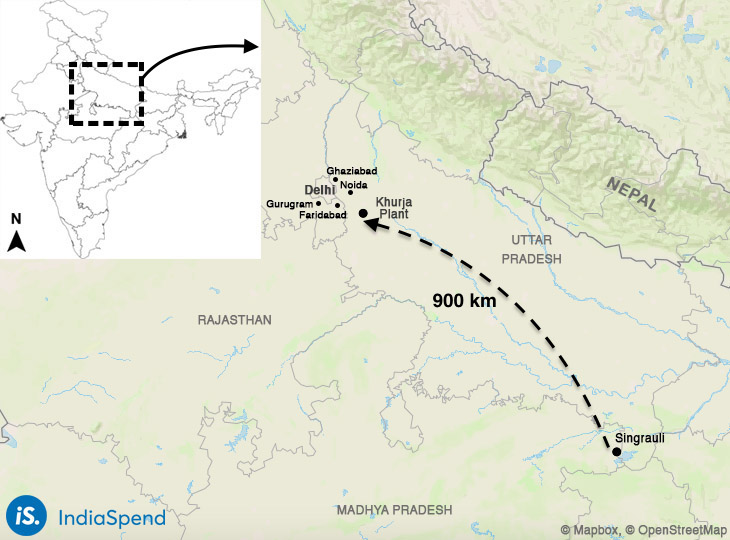
THDC India Limited's Khurja power plant in Uttar Pradesh is 900 km away from its feeder coal mine, in Singrauli, Madhya Pradesh. Analysts say the cost of transporting coal from the mine to the plant will add to costs.
THDCIL told IndiaSpend it remains committed to the $1.6-billion project and is "on track" to complete the under-construction plant by its 2022 target.
Industry monitors and observers have warned that this is an ill-conceived project, and one that incurs significant social and environmental damage while wasting significant sums of taxpayer funds on a plant that would be unviable even before it is switched on.
IndiaSpend contacted the Ministry of Power and the Ministry of Coal to ask why this plant is being constructed, despite evidence that it is not needed. We received no response. This report will be updated if either ministry responds.
This is the third of our multi-part, data-driven series, Environment Undone, which explores the environmental, ecological and human cost of India's chosen path of development. You can read part one here and part two here.
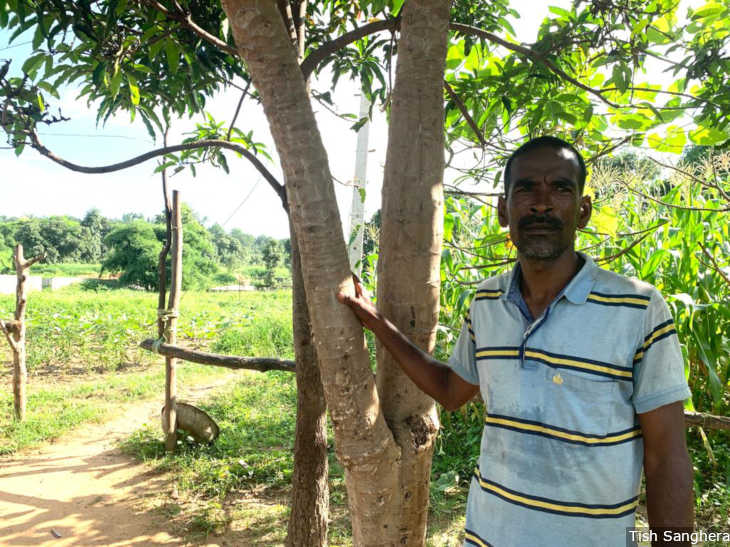
Mandhari Singh Gond, along with other villagers in Pidarwah, Madhya Pradesh, woke up one day in 2017 to discover that their lands had been allocated to THDC India Limited to build an opencast mine. They have been struggling ever since to get information on what happens next.
Coal power: India and the world
India is the world's second largest producer, importer and consumer of coal. The country consumed 968 million tonnes of coal during 2018-19, with around two-thirds (638 million tonnes) used to generate electricity, according to latest government data.
Much of the coal used to generate electricity in coal-fired power plants releases pollutants, such as sulphates, nitrates and fly ash
Three quarters of India's total electricity output comes from coal-fired power plants. Coal is expected to provide at least 50% of India's energy supply in 2030, as per CEA estimates, even as our share of electricity from renewable energy sources, such as wind and solar, is expected to rise from the current 9% to 35% by 2030.
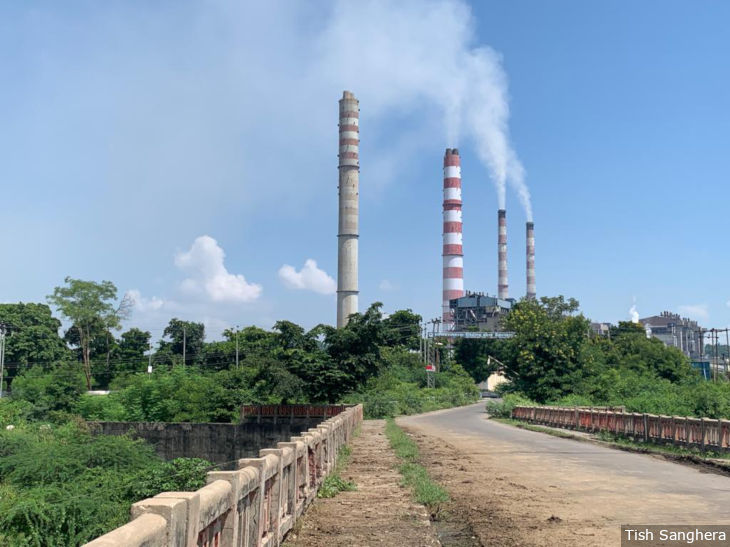
Around three-quarters of India's electricity is generated by coal plants such as this one operated by the National Thermal Power Corporation in Sonbhadra, Uttar Pradesh. The plant is on the eastern side of the Singrauli region in Madhya Pradesh, where THDC India Limited plans to build an opencast mine.
At the same time, 34 coal power plants in India have been designated as stranded assets
India has not joined the Powering Past Coal Alliance, a group of 30 countries working to advance to a complete transition to 0% coal use. Countries around the world, from Canada to Germany, are shunning coal-powered plants in favour of comparatively inexpensive renewable energy in an attempt to meet the Paris Agreement goal of keeping global temperature rise below 2 degrees Celsius above pre-industrial levels. In September 2019, United Nations Secretary-General António Guterres urged countries to end coal subsidies and not to build coal plants after 2020.
From deficit to surplus power
The Khurja Super Thermal Power project was conceived in 2010 in an attempt to address the 12.4% power deficit scenario in Northern India. As the project waited to take off, a coal plant construction boom spread across the country in the early years of the decade.
"This increase in capacity has outpaced the growth in demand, resulting in a declining trend of all-India Plant Load Factor
Analysts point out that the country's appetite to build more coal-fired power plants is inexplicable when faced with an existing supply glut and the plunging cost of renewables. The Sydney-based Institute for Energy Economics and Financial Analysis (IEEFA), predicted increased risk for the coal sector when it reported in September 2019 that India's coal capacity is already 20% higher than its national peak demand.
"The Khurja plant is simply the wrong technology, in the wrong place, at the wrong time," Tim Buckley, director of energy finance studies at IEEFA, told IndiaSpend. Buckley and his team analysed the NDA government's push to revive a plant proposal first conceived a decade ago, and under markedly different conditions; Buckley deemed it "economically illogical".
Analysts warn that the Khurja plant risks ending in economic as well as environmental disaster and ought to be cancelled.
Invaluable land
Many of Pidarwah's residents, including Mandhari Singh, are members of the Gond tribe, one of India's largest indigenous communities--numbering around 4.4 million in Madhya Pradesh--and the original inhabitants of the region's ancient sal
In recent decades, they have become silent witnesses as vast tracts of forest and fertile agricultural land have been cleared to make way for the mines and power plants that have made Singrauli India's energy capital.
Around 850,000 individuals are estimated to be affected by coal by 2025, environment non-profit World Wildlife Fund stated, citing data from the Ministry of Coal's The Coal Vision 2025 report. Many of them will be resettled in new areas and will be entitled to compensation to account for loss of earnings and property, in compliance with the Coal Bearing Areas Acquisition and Development Act.
Thousands who have already been displaced and moved into shoddy resettlement colonies, now live far from the forest and the economic security it provided. They have seen roads connecting the industrial plants to the highway get upgraded, but the jobs, schools and hospitals promised to them have not materialised.
In September 2019, IndiaSpend visited a resettlement colony, near Nagwa village in Singrauli, that houses families displaced by the Essar Mahan power plant. These residents complained about the lack of piped water, health facilities and employment opportunities. Most of all, they lamented the unreliable electricity supply despite living in India's power hub.
"They [Essar authorities] conducted some IT courses for our children and promised jobs in the [power] plant, but those have not come about," Kevala Prasad, a 70-something colony resident, told IndiaSpend. "Every worker [in the power plants] is from outside the area. They [the companies] are not interested in uplifting us, local people."
Essar "categorically deny [sic]" that conditions in their resettlement colony are sub-par. The company said it had provided free electricity to the colony and safe drinking water, that it regularly ran health camps and had employed 300 people. Residents who complained may be "motivated by vested interests", Essar told IndiaSpend in a statement when contacted.
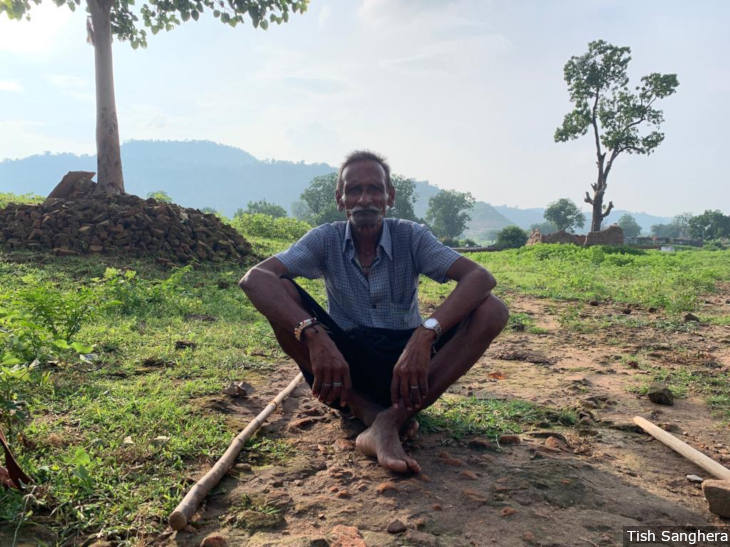
Kevala Prasad was displaced due to the construction of the Essar Mahan power plant in Singrauli in 2012. He now lives in a resettlement colony with no electricity, piped water or adequate health facilities.
There is a feeling among Pidarwah's residents that history might repeat itself.
"Some of my relatives, who were displaced by another [power] project about eight years ago, now live like animals in sheds, sleeping outside in the summer because it's too hot," an adivasi
Forest residents like Sonia say apart from farming income from maize and wheat, they can earn an additional Rs 50,000 ($700) a year by collecting forest plants such as tendu (used to make beedis or cigarettes) and mahua (a medicinal plant with multiple uses and much cultural significance).
"I've heard that other displaced people were promised certain compensation," added Sonia. "Later, they were given just Rs 8,000 ($113) and one labouring job in return for their plot… it was a family of eight."
The displaced residents' plight is well-known among others in the region and is one that those affected by new projects, like Sonia and Singh, say they will fight to avoid.
"This land has been cultivated by our forefathers," said Singh, perched on a dusty charpoy (a rope-strung cot) under the hot September sun, gazing at his neatly-sowed maize crop. "Even if we spend our whole life working on another piece of land, it would never be as productive as this. We will not leave this behind."
Soon after the overnight appearance of the land allotment sign in Pidarwah, the villagers sought answers from THDCIL's local office but grew none the wiser.
Some from Pidarwah's forest community pooled their meagre savings to seek legal support. They travelled to the Madhya Pradesh High Court, over 400 km away in Jabalpur, and met lawyers in an attempt to contest the acquisition order. They received little useful advice, ending their hope of relying on legal recourse.
Ensnared in India's mission to secure more accessible, domestic fuel sources, Pidarwah's residents remain on the backfoot. They are waiting for someone from "the company" to show up, tell them what lies in store and to discuss compensation.
In May 2020, IndiaSpend asked Singrauli's district collector K.V.S. Choudary why residents like Sonia and Mandhari Singh were yet to hear anything about the resettlement and compensation from the company or district officials, even two years after first being notified that their land had been acquired. He stressed that "every inch of land" acquired by THDCIL had been surveyed and visited by the local administration. If they later find eligible people "have been missed out, then we will fix it".
An "initial list of eligible PAFs (project-affected families) for resettlement benefits has been finalized", THDCIL stated in its March 2020 monthly status report. The list was to be published in local newspapers and online. Choudary told IndiaSpend that the list's publication had been delayed due to the COVID-19 lockdown.
Poor health, declining yields
"The taste of coal dust lingers constantly on my tongue," Kripanath Yadav, a farmer and anti-coal activist living in the shadow of Essar Mahan power plant in Singrauli, told IndiaSpend. "My white vest turns black after walking through the fields."
Yadav, 39, grows vegetables, rice, wheat, chickpeas and pulses on his two-acre farm. He never had to rely on fertiliser until the Mahan plant commenced operations in 2012. Spraying the fields has since become a necessity, he said.
The coal dust ejected from the plant and blasting from nearby mines--there are 11 in Singrauli, the second largest series of active coal mine groups in Asia--has diminished his crop yield by nearly 75% in seven years, he claimed. A quarter acre now yields 50 kg of produce compared to 200 kg earlier. "The monsoon rice harvest has not been affected, but we struggle to get by in the summers and winters," said Yadav.
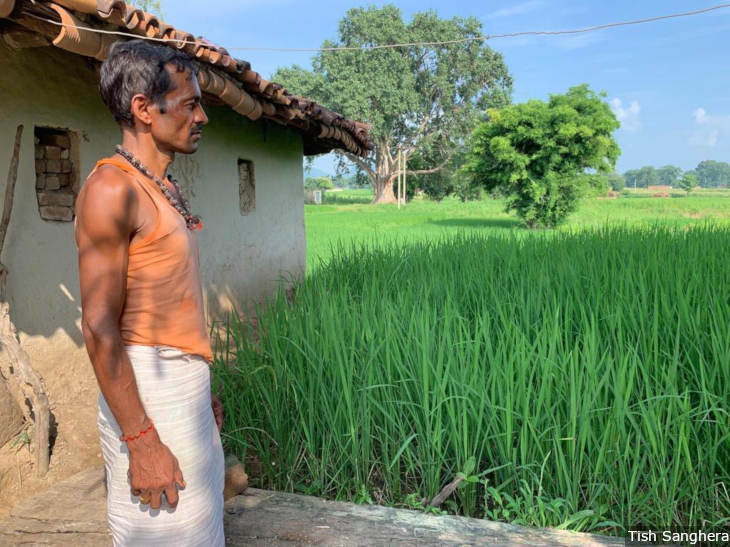
Kripanath Yadav, a farmer from Singrauli district in Madhya Pradesh, says his crop yield has declined by nearly 75% since 2012 when the Essar Mahan power plant commenced operations.
Declining crop yield is one of many problems that Yadav and fellow villagers face. Exposure to industrial by-products has left Singrauli's air, water and soil contaminated with toxic chemicals such as mercury, fluoride and coal dust. The local health centres are filled with patients suffering from conditions such as lung cancer, tuberculosis and skin diseases.
Pidarwah resident Dadini Gond doesn't know exactly why her relatives in other parts of Singrauli district fall sick more frequently compared to her own family. She figures it has something to do with the industry nearby, and worries that her children will grow up "weak" if the streams around them get polluted.
"The water in our stream is clear now. We use it for all our needs," Dadini said. "If you go to other villages, [you will see that] their water is dark and stinks. I wouldn't even let my animals drink from there."
Inviolate in the past, violate in the present
In 2009, a Central Empowered Committee (CEC) and the then environment ministry had denied forest clearance to the Amelia coal mine, which at the time was allocated to MPSMC. The Supreme Court also intervened on the basis of the CEC's recommendation and asked for the project to be scrapped. Later in 2012, the principal conservator of forests had also raised concerns that the mine would "result in fragmentation of the elephant corridor, which will adversely affect breeding of the elephant population".
The forewarnings did not prevent the current MoEFCC Forest Advisory Committee
The clearance was granted partly on account of the FAC members not personally sighting any wildlife during a two-day visit to the area in June 2018. In the site inspection report, local forest officials state the area is a wildlife corridor and that mining here has the "potential to disrupt the movement and increase the severity of the human-elephant conflict".
The MoEFCC's stage 1 forest clearance to the THDCIL mine is for a forest that sits adjacent to Mahan. Mahan has dense forests which the MoEFCC recognised as "inviolate
"This [clearance to a forest next to a declared inviolate forest] just shows that there is no logic in how forest clearances are granted," Nandikesh Sivalingam, director of the Delhi-based Centre for Research on Energy and Clean Air (CREA), told IndiaSpend. "THDCIL's Amelia mine has close to a million trees. Destroying that forest would cause irreversible damage to the ecosystem."
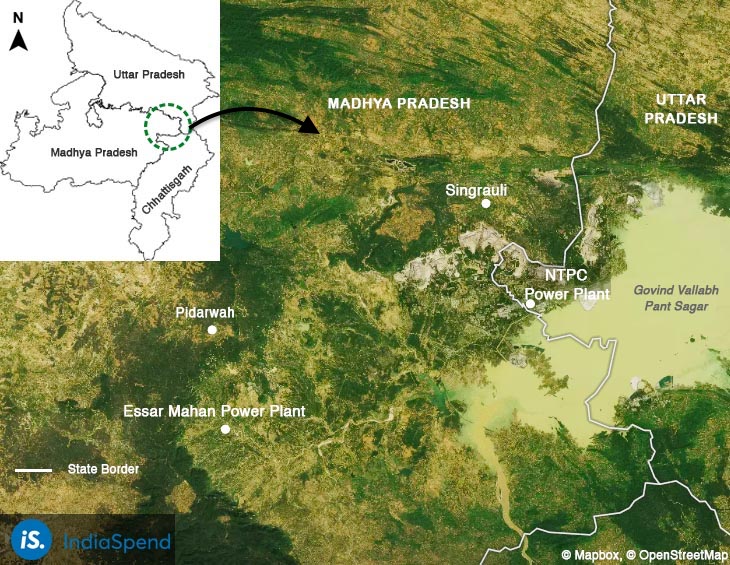
A reference satellite map showing India's energy capital, Singrauli, in Madhya Pradesh. THDC India Limited's proposed opencast mine is expected to come up on land upon which thousands of trees stand.
The concept of declaring certain forest areas within coal blocks as "inviolate" began under the United Progressive Alliance (UPA) government (2004-2009; 2009-2014). Its environment ministry classified certain forests as either 'go' or 'no-go' areas and banned mining from taking place in the latter (the terminology was changed to 'violate-inviolate' sometime around 2012, as per this report by the then Ministry of Environment and Forests).
Around 57% of identified land within coal blocks across India were classed as 'no-go' areas in 2010. This was met with sustained objection from the Ministry of Coal, which wanted the categorisation to be disbanded. The parameters for determining no-go areas were altered later in the year upon the coal ministry's and Prime Minister Manmohan Singh's office's request; the 'no-go' classed areas within coal blocks subsequently fell to 23%.
The violate-inviolate forest concept has not been formally adopted via a notification or legal policy by any government regime and is used solely as a reference tool by the FAC, tasked with appraising coal mining applications, observers say. It is one reason why even dense forests, known to house endangered species, are never fully off the table as far as project proponents are concerned.
"This decision on the THDCIL mine shows that these guidelines can always be bent, since the inviolate areas concept currently has no legal standing," Sharachchandra Lele, distinguished fellow in environmental policy and governance at the Ashoka Trust for Research in Ecology & the Environment (ATREE), told IndiaSpend. "Even if we have maps of inviolate areas, it would not imply that these forests enjoy a higher degree of protection."
In the stage 1 forest clearance granted to THDCIL for the opencast mine in Amelia North coal block, the FAC ruled that eight of 14 "inviolate" areas should not be cleared for mining but that the remaining six, totalling 379 hectares, in the total forest area could be diverted.
Environmentalists warn that opencast mining in the forests surrounding Pidarwah will take a significant toll on local wildlife populations.
The mine's proximity to PAs such as the Sanjay Dubri National Park and Bagdara Wildlife Sanctuary means the land is often crossed by tigers, elephants and other protected species. It is further reason why "given their biodiversity value, forest clearance must not be granted to… Amelia North coal block, or any other in this area", non-government organisation Greenpeace had pointed out in its 2012 report, Trashing Tigerland.
Apart from forest clearance, THDCIL will also require an EC to be able to work on the colliery. An EC application is preceded by an Environmental Impact Assessment
The MoEFCC considers ECs granted for mining projects to be valid for 30 years. As a result, THDCIL will inherit the EC granted to the previous company that was allocated the land, i.e. the MPSMC, in 2007. This EC, although granted more than 10 years ago, still stands, despite the demographic and ecological changes to the area over this period.
Given that THDCIL will not be required to conduct a fresh EIA for its opencast mine in Singrauli, it reduces the opportunity for public scrutiny.
Sivalingam, of CREA, condemns the fact that such clearance transfers have become "common practice". That an EIA conducted over a decade ago, under very different conditions, remains valid is a "significant issue", he said. "It makes it harder for the general public to form an accurate picture of a project's potential impact."
Tale of two petitions
Straddling the Uttar Pradesh and Madhya Pradesh border, Singrauli is the fourth most critically polluted industrial cluster in India, according to a Central Pollution Control Board (CPCB) index. Six major thermal power plants are located in the district.
In June 2014, the newly-elected NDA government lifted a ban on new industrial projects and expansion of existing ones in Singrauli and other polluting industrial clusters. The ban on these activities had been ordered in September 2013 by the then environment ministry after the CPCB found "no improvement" in pollution levels.
With the ban lifted and new industrial projects in the works, local activists like Jagat Narayan Vishwakarma fear the pollution is worsening. "All the ponds are full of waste. The streams from which most people draw water are also polluted," Vishwakarma told IndiaSpend.
He says companies continue to dump fly ash in water bodies despite the CPCB's order mandating that 100% of the fly ash must be reused. "There's no retribution for them [polluting companies]," he said. "They can [pollute], and so they do."
This issue of non-compliance received national media attention recently after three different power plants--Essar, NTPC and Reliance--experienced a breach in their ash ponds
Vishwakarma, a resident of Govindpur, 60 km from Singrauli, in Uttar Pradesh, filed a petition in the National Green Tribunal
"A lot of people are dying [due to pollution-linked cancers] as of now, but we can't prove why without evidence," said the 46-year-old, who uses a walking stick due to his fluorosis-affected knee.
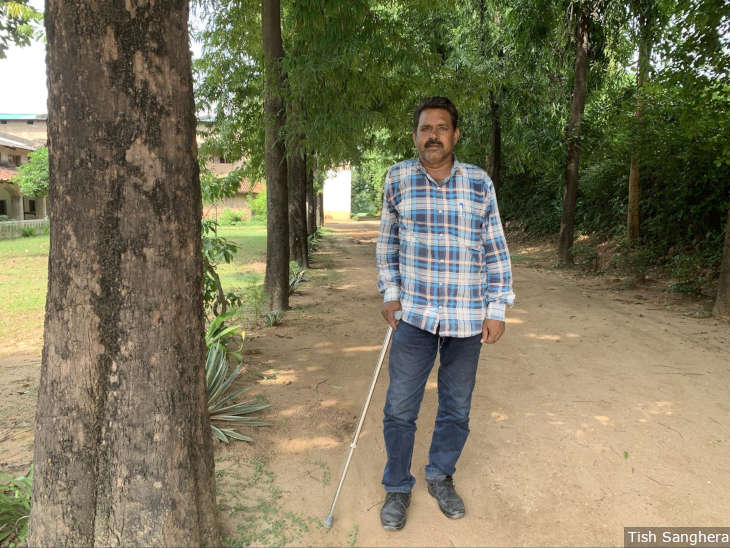
Jagat Narayan Vishwakarma, 46, has filed a petition in the National Green Tribunal over increasing industrial pollution and non-compliance by companies in the Singrauli area.
Nine hundred kilometres away in Khurja, similar environmental concerns abound. Many are perplexed that a new coal-fired power plant has been approved given the region already suffers from air pollution and stressed water resources. Non-government organisation Social Action For Forest and Environment (SAFE) brought a case in the NGT against the MoEFCC and the Uttar Pradesh Pollution Control Board in 2017 for granting environment clearance to the Khurja plant.
The petition challenges "the correctness of the Ambient Air Quality data furnished by the Project Proponent" i.e. THDCIL.
Vikrant Tongad of SAFE believes the company intended to mask the project's potential impact. "Their [THDCIL's] data says the air quality in Khurja is better in the winter than in the summer. This is simply ridiculous," Tongad told IndiaSpend. During the colder months, a combination of factors such as stubble-burning and a dip in temperatures leads to more pollution particles becoming trapped in the air. It's proof, he claims, that the authorities did not examine the facts properly, having already decided that the project will get approval.
The Tribunal sent representatives from the CPCB and the Indian Institute of Technology-Delhi (IIT-Delhi) to collect accurate data on the region's air quality. The representatives returned with similar data which again showed PM 2.5 levels to be higher in summer compared to the winter data reported in the EIA.
Although the NGT asked IIT-Delhi in December 2019 to conduct the study one more time, Ritwick Dutta, the lawyer representing SAFE, said the institute will likely report similar findings. "They [IIT-Delhi] will go and do a single-day study again," Dutta told IndiaSpend. "They ought to be taking readings over multiple days and months in order to get a realistic picture."
He pointed out that committees reviewing proposals are no longer made up of environment experts and that they barely follow any appraisal process, as IndiaSpend reported in part one of this series. "It's the tendency of EIA consultants to copy-paste data from other reports," he said, adding that the EAC should pick up on this during the review process. "But the EAC is simply a committee that comes to clear projects. It's a rubber stamp authority."
"Delhi is already a gas chamber," Tongad said. Pollution from power plants located within a 300-km radius of the capital have been identified as a major source of air pollution, "so how can the Khurja plant [about 95 km from Delhi] be given the go-ahead?"
Environment minister Prakash Javadekar played down the impact of India's air pollution crisis in December 2019 when he said that there is no link between air pollution and reduced life expectancy. Studies have shown otherwise. Burning coal contributed close to a fifth of the 500,000 premature deaths caused by air pollution in 2016, according to The Lancet Countdown 2019 report.
"Economically illogical"
The Khurja plant risks being outdated before it even begins operations, according to power sector analysts.
One of the main problems lies in the cost of transporting the plant's coal 900 km north--from the Amelia North coal block in Madhya Pradesh to Khurja in Uttar Pradesh--given that Indian Railways continues to hike freight charges. Freight costs (charged per tonne/km) doubled from Rs 0.83 in 2006 to Rs 1.69 in 2017, according to research organisation Brookings India.
This will drive up the estimated unit price of the Khurja plant's electricity to an uncompetitive Rs 5.67/kilowatt hour (kWh), as calculated by energy think-tank IEEFA. The tariff is 56% higher than other coal-fired plants at Rs 3.64 kWh in 2017, whose mines are typically located nearer by, and close to double that of solar and wind electricity tariffs of around Rs 2.9 kWh in 2017 as calculated by The Energy and Resources Institute (TERI).
Essentially, energy distribution companies will have "no incentive to buy Khurja's super-expensive electricity", IEEFA's Buckley said.
He pointed to China where around 8.7 GW of supercritical plants--the same technology as proposed for Khurja--have been earmarked for closure after running for around 10 years. Despite their 40-year lifespan, the plants are considered too polluting and surplus to requirements as the country focuses on cleaner, renewable energy balanced by flexible peaking capacity.
"You've got to have rocks in your head if you want to build a plant with outdated supercritical technology in 2020," Buckley added, because in the next 10-15 years, "it's unlikely that that plant [Khurja] will be allowed to operate, except at 30-40% of the time at peak demand".
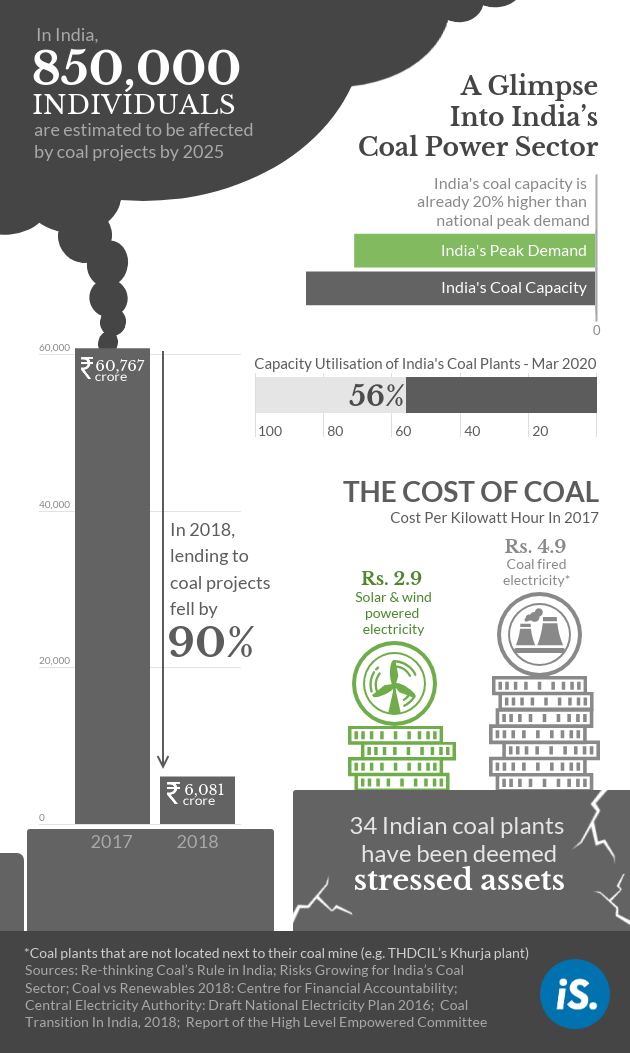
THDCIL's leadership is confident that the Khurja plant will be able to operate at 85% PLF, according to its chairman and managing director DV Singh. "We don't see this plant being stranded or operated at a lower PLF either," Singh told IndiaSpend. "We don't have all those worries."
He added that the Khurja plant's electricity rate, which takes into account higher freight charges, will be "very competitive". The company had even revised its projections downwards, from Rs 4.31/kWh to Rs 3.61/kWh since 2015.
"The bidding cost for supercritical technology, which has been maturing day by day, was lower than the estimated costs," Singh told IndiaSpend. These savings have enabled Khurja's electricity to be priced competitively, he said.
But few consider these numbers--and the need for the Khurja plant--to be credible.
"This is blatant misinformation," Sivalingam said. "A closer look at the cost of coal power commissioned in 2018-19 would show that [operating] costs have gone up to more than Rs 4.5/kWh already for plants that are not located next to their mines. There is no way THDCIL will be able to provide power in 2023 at the rate they are claiming without incurring massive losses."
"They say we need to expand coal production, but the situation on the ground is just very different," Vibhuti Garg, a senior advisor at IISD, told IndiaSpend. "There's no demand for such capacity. Building new coal capacity is a sin when around 40 GW of existing assets are already stranded."
Excluded and ignored
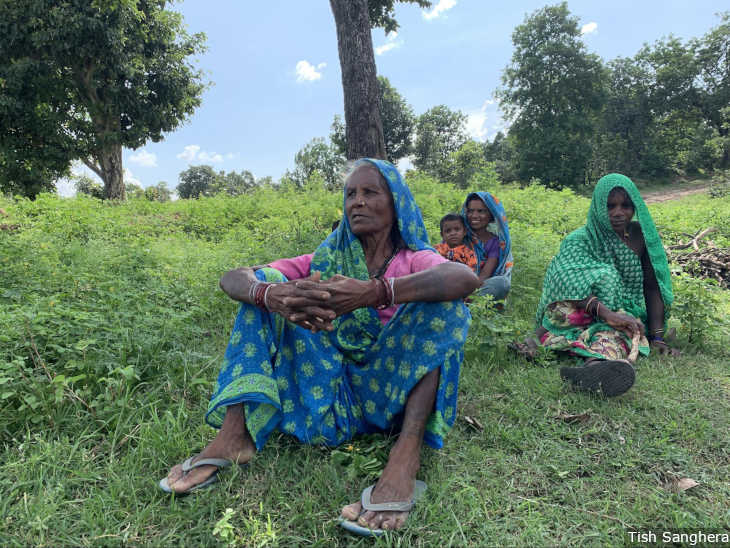
Sonia, an eldery adivasi resident of Pidarwah, Madhya Pradesh, faces displacement due to THDC India Limited's proposed opencast mine in Singrauli district. She is reluctant to swap her forest home for the resettlement colonies.
The Centre's thrust for the Khurja power plant is manifest in the project's implementation. For instance, while granting the stage 1 forest clearance to the Amelia North coal block, the Additional Principal Chief Conservator of Forests in the Bhopal regional office noted that the forest could be cleared "keeping in view the national perspective" of THDCIL's project and "for meeting the energy needs of the country".
The notion that those tasked with protecting the forests should instead propose its clearance does not bode well for stakeholders, including the residents of Pidarwah, and others affected by the Khurja project.
"It's always intrigued me that forest department officials, who one would expect to be territorial about protecting their forest, are only too willing for these areas to be diverted for non-forest uses," Amita Baviskar, professor of sociology at the Institute of Economic Growth, Delhi, and a former member (2010-12) of the Forest Advisory Committee, told IndiaSpend.
Most of these officials see nothing wrong in destroying forests in the cause of economic growth, she said, and added that some officials may also privately benefit from such decisions. "The social impact, especially on local marginalised populations, is the last thing that forest officials in most states worry about," Baviskar said.
Project proponents and local officials are known to rely on optics in order to procure swift approvals and avoid construction delays. They hold mandatory public meetings far away from the affected areas, invite only those who are sympathetic to the agenda or display critical information in a language, typically English, that few locals will comprehend, studies have noted.
THDCIL said it posted a notice in July 2018 for "the general public to submit their objection, if any, within 30 days", according to one of its project reports. It is unclear though how well these types of notices were publicised, and if the news reached everyone affected, especially those from the adivasi community like Mandhari Singh and Sonia, who live in more remote areas.
None of the 15 residents, including Singh, that IndiaSpend spoke to in Pidarwah were aware that they had an opportunity to make their objections against the mine heard in July 2018. Their fears of exclusion are also represented in the documents attached to THDCIL's stage 1 forest clearance.
The site inspection report states no Scheduled Caste or Scheduled Tribe people will be affected by the project and that the forest has no socio-religious significance.
This is untrue. The Gonds depend on the diverse mix of vegetation for their livelihood and worship their deity in the local forests.
"We didn't receive any communication from the government or the company," said Mandhari Singh. "If they [local authorities or company officials] ever did a survey in our village, then they would know the real population of the adivasi community, and we would be less worried. Nobody has come to do this."
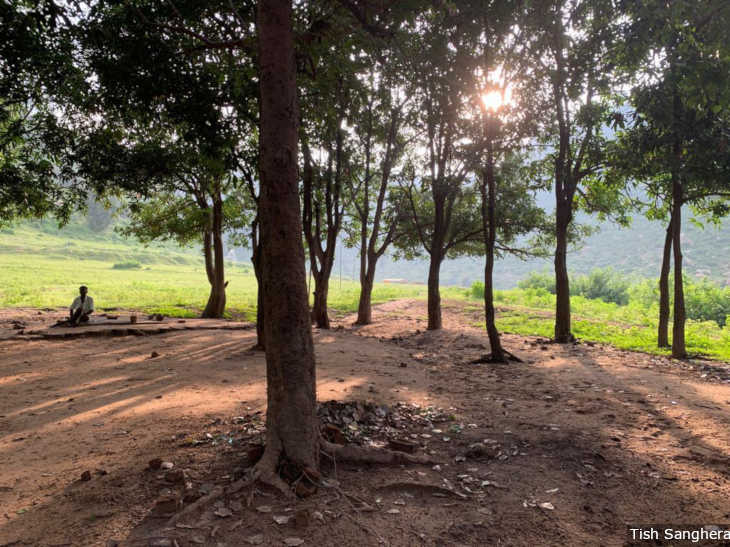
A sacred grove in a forest close to Pidarwah, Madhya Pradesh. Gond tribals worship their deity in such groves. State forest officials have stated in a site inspection report that the forest has no socio-religious significance, and that no Scheduled Castes or Scheduled Tribes people will be affected if this land is cleared for a mining project.
These kinds of issues are not uncommon since the appraisal process tends to ignore the livelihood or cultural dependence of people living around such areas, policy expert Kanchi Kohli from the Centre for Policy Research, told IndiaSpend. It could also be a result of recording villages or farms around forests as non-forest land. "Project authorities look at government files [to know the land's legal status], and not how the land is actually being used," she added.
Kohli says that in most instances, there are no site inspections by appraisal committees to address these issues and the law does not have space to seek public opinion. "Facts that are proactively put before a committee may get addressed, but this is not a common practice," she said.
THDCIL's Singh maintains, without sharing details, that everyone affected would have been "approached and informed" of the project, and that all survey work was completed by end-2018. "There should be no [cause to] worry because this is a PSU project and we work as per the rules," said Singh, implying there should be greater trust in state-owned companies than in private-sector mining projects. "I don't see any mismatch. All due procedures will be taken care of."
For those like Mandhari Singh, staring at sal trees that may soon be flattened by company bulldozers, the reality is stark. "They will mine this coal and burn it for no more than 30 years. We will lose our forests forever."
This is the third of a five-part series that explores the environmental, ecological and human cost of India's chosen path of development. You can read the first part here, the second here, the fourth here and the concluding part here.
(Sanghera is an independent journalist. Graphics by Jameela Ahmed and Vishal Bhargav. Editing by Marisha Karwa.)
We welcome feedback. Please write to respond@indiaspend.org. We reserve the right to edit responses for language and grammar.


